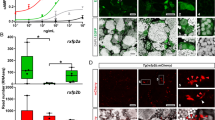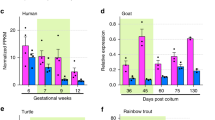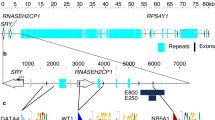Abstract
THE CREM (cyclic AMP-responsive element modulator) gene encodes multiple regulators of the cAMP-transcriptional response by alternative splicing1. A developmental switch in CREM expression occurs during spermatogenesis, whereby CREM function is converted from an antagonist to an activator (CREMτ; ref. 2) which accumulates to extremely high levels from the premeiotic spermatocyte stage onwards. To define the physiological mechanisms controlling the CREM developmental switch, we have hypophysectomized rats and observed the extinction of CREMτ expression in testis, thereby demonstrating a central role of the pituitary-hypothalamic axis. We then used the seasonal-dependent modulation of spermatogenesis in hamsters to dissect the hormonal programme controlling this developmental process. By this approach, combined with direct administration of pituitary-derived hormones, we have established that follicle-stimulating hormone (FSH) is responsible for the CREM switch. FSH appears to regulate CREM expression by alternative polyadenylation, which results in a dramatic enhancement of transcript stability.
This is a preview of subscription content, access via your institution
Access options
Subscribe to this journal
Receive 51 print issues and online access
$199.00 per year
only $3.90 per issue
Buy this article
- Purchase on Springer Link
- Instant access to full article PDF
Prices may be subject to local taxes which are calculated during checkout
Similar content being viewed by others
References
Foulkes, N. S., Borrelli, E. & Sassone-Corsi, P. Cell 64, 739–749 (1991).
Foulkes, N. S., Mellström, B., Benusiglio, E. & Sassone-Corsi, P. Nature 355, 80–84 (1992).
Santen, R. J. in Endocrinology and Metabolism (eds Felig, P., Baxter, J. D., Broadus, A. E. & Frohman, L. A.) 821–905 (McGraw-Hill, New York, 1987).
Crowley, W. F. Jr et al. Rec. Progr. Horm. Res. 47, 27–67 (1991).
Rubin, M. R., Toth, L. E., Patel, M. D., D'Eustacchio, P. & Nguyen-Huu, M. C. Science 233, 663–667 (1986).
Reiter, R. J. Endocrin. Rev. 1, 109–131 (1980).
Desjardins, C., Ewing, L. L. & Johnson, B. H. Endocrinology 89, 791–800 (1971).
Pévet, P. Reprod. Nutr. Dev. 28, 575–578 (1988).
Bartke, A. in The Hamster Reproduction and Behavior (ed. Siegel, M. I.) 73–98 (Plenum, New York, 1985).
Jetton, A. E., Fallest, P. C., Dahl, K. D., Schwartz, N. B. & Turek, F. W. Endocrinology 129, 1025–1032 (1991).
Shaw, G. & Kamen, R. Cell 46, 659–667 (1986).
Habener, J. Molec. Endocrinol. 4, 1087–1094 (1990).
Foulkes, N. S. & Sassone-Corsi, P. Cell 68, 411–414 (1992).
Klemcke, H. G., Vensickle, M., Bartfe, SA., Amador, A. & Chandrashekar, V. Biol. Repr. 37, 356–370 (1987).
Jégou, B. et al. in Spermatogenesis—Fertilization—Contraception (eds Nieschlag, E. & Habenicht, U.-F.) 57–95 (Schering Foundation Workshop 4, Springer, 1992).
Johnson, P. A., Peschon, J. J., Yelick, P. C., Palmiter, R. D. & Hecht, N. Biochem. biophys. Acta 950, 45–53 (1988).
Raynaud, F. & Pévet, P. J. neur. Transm. 83, 235–242 (1991).
Vulliamy, T. J. et al. Proc. natn. Acad. Sci. U.S.A. 85, 5171–5175 (1988).
Marzluff, W. F. & Huang, R.-C. C. in Transcription and Translation—A Practical Approach (eds Hames, B. D. & Higgins, S. J.) (IRL, Oxford, 1986).
Author information
Authors and Affiliations
Rights and permissions
About this article
Cite this article
Foulkes, N., Schlotter, F., Pévet, P. et al. Pituitary hormone FSH directs the CREM functional switch during spermatogenesis. Nature 362, 264–267 (1993). https://doi.org/10.1038/362264a0
Received:
Accepted:
Issue Date:
DOI: https://doi.org/10.1038/362264a0
This article is cited by
-
SOX30 is required for male fertility in mice
Scientific Reports (2017)
-
Wide distribution of CREM immunoreactivity in adult and fetal human brain, with an increased expression in dentate gyrus neurons of Alzheimer’s as compared to normal aging brains
Amino Acids (2013)
-
Cell-specific occupancy of an extended repertoire of CREM and CREB binding loci in male germ cells
BMC Genomics (2010)
Comments
By submitting a comment you agree to abide by our Terms and Community Guidelines. If you find something abusive or that does not comply with our terms or guidelines please flag it as inappropriate.



